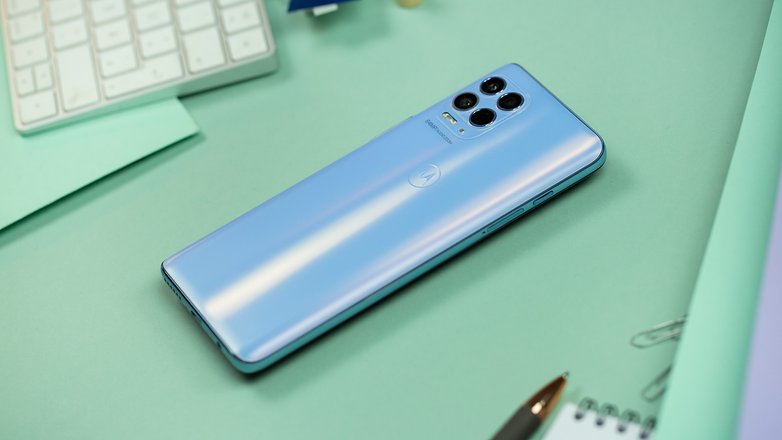Motorola Moto G100 Review: Identity crisis


The "most powerful Moto G ever," Motorola said when announcing the Moto G100 in several markets. Along with the specs upgrade, however, came a price increase that pushed the phone away from the market range traditionally occupied by the Moto G family. But has the Motorola's cost-benefit kept up with all these upgrades? That's what NextPit answers in this review.
Good
- Excellent and stable performance
- Great battery life
- Good screen, although LCD and "only" 90 Hz
- Headphone jack and microSD card slot
Bad
- Not very versatile camera
- No wireless charging
- No IP certification
- Below average upgrade policy

Motorola Moto G100 in a nutshell
The Moto G100 breaks the tradition of the cell phone family by adopting the powerful Qualcomm Snapdragon 870 processor. The component is basically an updated version of the 865 chip that equipped most top-of-the-line devices in 2020. At the same time, the technical improvement was accompanied by an also considerable price jump, launched at $599.
At the time of publishing this review, the Moto G100 can be found for $385. For the price, the customer gets a huge 6.7-inch LCD screen with a 90 Hz refresh rate, the aforementioned top-of-the-line processor, 5G connection, triple camera with 64 MP main sensor, plus a 5,000 mAh battery with included 20 W charger.

Design and Display: pure Motorola recipe
The Moto G100 brings the traditional look of Motorola phones, with a large screen and reasonably discreet edges on the front and a plastic-finished back, where the camera module and the manufacturer's logo stand out, but without the traditional fingerprint scanner.
What I liked:
- Good quality plastic finish.
- Correct screen, although technically inferior to rivals.
- Headphone output.
What I didn't like:
- Mono speaker.
- No IP certification.
Although the device is a bit too large for my taste, the market preference is clearly this, so fit this feature into the field above that aligns with your personal taste.
Be that as it may, the Moto G100 is a well-built handset, with an attractive gradient finish to the plastic back cover. Instead of installed under the brand logo, the biometric reader is located on the power button, positioned on the side of the device. Those who are used to large cell phones quickly get used to the location of the buttons on the phone, which have a good tactile response.

The LCD screen has good color and contrast levels, even for this humble journalist who is used to AMOLED displays. In addition, the 90 Hz refresh rate offers fluid animations on the screen, even though it does not offer the 120 Hz found in rival models like the Redmi Note 10 Pro or Galaxy S20 FE.
Considering the market in 2021, the Moto G100 also gains points for including a headphone output. On the other hand, it loses points for the mono speaker output and for not including an IP certification for water and dust resistance.
Performance and System: Moto G100 Highlights
Those who are used to seeing Moto G phones equipped with intermediate Snapdragon 600/400 processors are even surprised to find the Moto G100. The performance of the Snapdragon 870 is worthy of a premium smartphone and even brings support for 5G connections.
What I liked:
- Great performance, no stability issues.
- Competent in games.
- NFC for payments.
- Expansion with microSD cards.
What I didn't like:
- Advertisements in the interface.
- Lackluster track record of version and security updates.
While the Snapdragon SoC promises plenty of performance for a few years, the promised updates for the device are discouraging, following the current history of only one new version of the Android system and two years of security updates. This means Android 12 and security patches until March 2023.

Another characteristic in terms of hardware is the memory configuration, with 8 GB of RAM and 128 GB of storage. In addition, the Moto G100 is compatible microSD memory cards and payment systems via NFC.
| Benchmarks | Motorola Moto G100 | Samsung Galaxy S20 FE | Motorola Edge 20 |
|---|---|---|---|
| 3DMark WildLife Stress Test | 4172 ~ 4193 | 3513 ~ 3932 | 2461 ~ 2494 |
| Geekbench (single/multi) | 950 / 2816 | 901 / 3222 | 768 / 2776 |
| AnTuTu | 680.582 | 647.121 | n/a |
The Moto G100 smoothly ran games like Call of Duty Mobile, Free Fire and Genshin Impact, the latter with high quality graphics and frame rate at 60 FPS. And as the 3D Mark Stress Test result shows, the Snapdragon 870 did not show any thermal bottleneck or overheating issues, with a stable score in the benchmark.
On the other hand, although Motorola's system modifications are reasonably unobtrusive, with a handy game panel with shortcuts for Twitch broadcasts, screen recording, and call and notification blocking, the brand's skin includes advertisements in the system notifications. And some people may find the amount of feature suggestions and settings in the interface excessive, reminiscent of the startup time of some tutorial-dominated games.
A not versatile camera

The Moto G100 has a triple camera set, only two of which are usable—the 64-megapixel main sensor and the 16 MP ultra-wide camera that also works for macros—, the other two circles in the camera suite house the 2 MP depth sensor and a ToF (time of flight) sensor, which in theory have similar functions, but the latter is used for laser autofocus.
What I liked:
- Macro mode worked better than expected.
What I didn't like:
- Module not very versatile.
- Color reproduction a bit lackluster.
The Moto G100's photos in good lighting conditions are correct and quite usable for sharing on social networks and messaging apps . The color processing tends toward a more natural reproduction, but with a result that looks a bit washed out.
By default the main camera generates 16 megapixel images using pixel binning. It is possible to use the "Ultra-res" mode for recording files with the original sensor resolution of 64 megapixels, while the ultra-wide camera records 16 megapixel files, but with a clear loss of detail, especially in low light.
Speaking of night photos, Night Vision mode repeated the impressions reported by my colleague Camila Rinaldi in the Moto G30 review, with a loss of a lot of detail, especially in shots without a tripod, thanks to the exposure time required. The photos with the mode off had a better result than expected, with a good level of detail, although with a certain level of noise.
The macro mode also had better results than its hybrid setting - using the ultra-wide camera - suggests. Although the result is not good enough for prints or enlargements, the images are far superior to (many) models with dedicated 2-megapixel macro cameras...
This hybrid use of the ultra-wide camera makes one wonder why Motorola didn't do the same with the Moto G100's ToF sensor, which could take over the functions of the depth sensor and make room for a telephoto camera, found on the Galaxy A72, for example.

The savings applied to the rear assembly did not affect the selfie camera, which features two lenses, a main lens with a 73° field of view and an ultra-wide one with 118°. Images are slightly more saturated on the ultra-wide camera, but both do their job well, as does portrait mode, in both cases without the exaggerated "beauty filter," which fortunately is adjustable in the camera app.
Excellent autonomy of use
The Moto G100 comes with the 20 W Turbo Power charger in the package, responsible for powering the 5,000 mAh battery.
What I liked:
- Excellent battery life.
What I didn't like:
- Not so fast charging.
- No wireless charging.
During testing, battery life was one of the highlights of the Moto G100, with approximately two days of operation with average use. It would not be surprising if the use of the power-saving features extended the time to an additional day, depending on the apps and games used, of course.

In contrast to its Chinese countrymen, Lenovo did not equip the Moto G100 with fast charging, a few years ago the "Turbo Power" charger does not deserve that name, with full recharge times of about 1h45min. The recharge rate is similar to that of the Samsung Galaxy S20 FE, which has lower charging capacity and power.
| Recharge | Motorola Moto G100 | Samsung Galaxy S20 FE |
|---|---|---|
| 5 minutes | 7% | 6% |
| 20 minutes | 26% | 25% |
| 1 hour | 74% | 65% ~ 75% |
| 100% | 1h45 | 1h40 |
| PCMark Battery Life | 18h50min | 12h12min |
Datasheet and other information
I list below other points that may be of interest to the NextPit community, but did not warrant additional paragraphs:
- The software version during the test was RRTS31.Q1-84-24-1-4 (September / 2021).
- After resetting the updated handset, the system indicated 21.53 GB used.
- The packaging of the tested handset included the 20 W charger, charging cable, protective cover and the SIM tray opening tool.
- The Moto G100 uses the partition technique for faster installation of updates.

Moto G100 Bottom Line: Highs and lows
The Moto G100 is a mix of strengths and weaknesses, with impeccable performance thanks to the Snapdragon 870 processor and 5G compatibility, a screen that on paper lags behind the competition but in practice is perfectly adequate, and excellent battery life.

On the other hand, the camera not very versatile, the weak update policy of Motorola and the absence of features such as water and dust resistance certification. On the other hand, the camera's lack of versatility, Motorola's weak update policy and the absence of features such as water and dust resistance certification and wireless recharging take away the potential of the device to be a true flagship killer.
Over the course of the year—and perhaps the arrival of more rivals from Realme, Samsung, Xiaomi and other manufacturers—it's worth keeping track of Moto G100 promotions. If Motorola manages to maintain or reduce the currently found price of $385, the phone has everything to establish itself as a competitive option, and perhaps do justice to the name of Motorola's best-selling line.

































